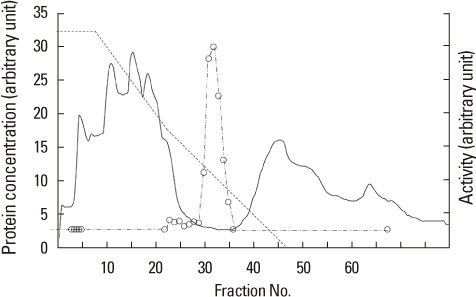Endocrinol Metab.
2012 Dec;27(4):282-288. 10.3803/EnM.2012.27.4.282.
Expression and Purification of Phospholipase C-beta4, and Chimeric Phospholipase C and Characterization of Them
- Affiliations
-
- 1Department of Internal Medicine, Seoul National University College of Medicine, Seoul, Korea. djpark@snu.ac.kr
- KMID: 1973790
- DOI: http://doi.org/10.3803/EnM.2012.27.4.282
Abstract
- BACKGROUND
Phospholipase C-beta4 (PLC-beta4) is known to be one of the most important signal transducing molecules; however, its biophysical and chemical characteristics are not well known due to the difficulty in purifying PLC-beta4 from bovine retina. In the present study, we used the baculovirus expression system in order to express and purify large amounts of PLC-beta4. With this system, we also tried to produce chimeric PLC-beta3/beta4 and PLC-beta4/beta3 protein in order to study the structure-activity relationship between N terminal and C terminal portion of PLC-betas.
METHODS
I cloned PLC-beta4 to the baculovirus expression system by the polymerase chain reaction method and infected the PLC-beta4 to Sf9 cells. I purified recombinant PLC-beta4 proteins using sequential high performnance liquid chromatography (HPLC) by using the TSK phenyl-5PW column and the TSK heparin-5PW column. With this similar method, I was able to express chimeric PLC-beta3/beta4 and PLC-beta4/beta3 proteins.
RESULTS
With the two step HPLC, I was able to purify PLC-beta4 by 30-fold; this purified PLC-beta4 contained PLC activity. I also expressed chimeric PLC-beta3/beta4 and PLC-beta4/beta3 using the baculovirus system, and their expression was confirmed by the immunoblot method. However, chimeric PLC-beta4/beta3 did not show PLC activity, while chimeric PLC-beta3/beta4 retained its PLC-activity.
CONCLUSION
Expression of chimeric PLC-beta4 using the baculovirus system was an efficient method to obtain a large amount of protein. Moreover, this expression and purification method would be useful in studying the physical and chemical characteristics of this protein. In my study using chimeric PLC-beta protein by swapping the N terminal and C terminal portions of PLC-beta3 and beta4, chimeric protein lost its activity completely in PLC-beta4/beta3 chimera. This result suggested a minute change in the tertiary structure of the protein, which may significantly affect its function.
MeSH Terms
Figure
Reference
-
1. Noh DY, Shin SH, Rhee SG. Phosphoinositide-specific phospholipase C and mitogenic signaling. Biochim Biophys Acta. 1995. 1242:99–113.2. Rhee SG, Choi KD. Regulation of inositol phospholipid-specific phospholipase C isozymes. J Biol Chem. 1992. 267:12393–12396.3. Rhee SG. Regulation of phosphoinositide-specific phospholipase C. Annu Rev Biochem. 2001. 70:281–312.4. Harden TK, Sondek J. Regulation of phospholipase C isozymes by ras superfamily GTPases. Annu Rev Pharmacol Toxicol. 2006. 46:355–379.5. Lee SB, Rhee SG. Significance of PIP2 hydrolysis and regulation of phospholipase C isozymes. Curr Opin Cell Biol. 1995. 7:183–189.6. Feng JF, Rhee SG, Im MJ. Evidence that phospholipase delta1 is the effector in the Gh (transglutaminase II)-mediated signaling. J Biol Chem. 1996. 271:16451–16454.7. Homma Y, Emori Y. A dual functional signal mediator showing RhoGAP and phospholipase C-delta stimulating activities. EMBO J. 1995. 14:286–291.8. Zhang L, Malik S, Kelley GG, Kapiloff MS, Smrcka AV. Phospholipase C epsilon scaffolds to muscle-specific A kinase anchoring protein (mAKAPbeta) and integrates multiple hypertrophic stimuli in cardiac myocytes. J Biol Chem. 2011. 286:23012–23021.9. Lee CW, Park DJ, Lee KH, Kim CG, Rhee SG. Purification, molecular cloning, and sequencing of phospholipase C-beta 4. J Biol Chem. 1993. 268:21318–21327.10. Jhon DY, Lee HH, Park D, Lee CW, Lee KH, Yoo OJ, Rhee SG. Cloning, sequencing, purification, and Gq-dependent activation of phospholipase C-beta 3. J Biol Chem. 1993. 268:6654–6661.11. Park D, Jhon DY, Lee CW, Lee KH, Rhee SG. Activation of phospholipase C isozymes by G protein beta gamma subunits. J Biol Chem. 1993. 268:4573–4576.12. Park DJ. Expression of phospholipase C-B3 using recombinant baculovirus expression system. J Korean Soc Endocrinol. 1997. 12:283–294.13. Gruenwald S, Heitz J. Baculovirus expression vector system: procedures and methods manual. 1993. 2nd ed. San Diego: PharMingen;5.14. O'Reilly DR, Miller L, Luckow VA. Baculovirus expression vectors: a laboratory manual. 1992. New York: W. H. Freeman.15. Smith MR, Liu YL, Kim H, Rhee SG, Kung HF. Inhibition of serum- and ras-stimulated DNA synthesis by antibodies to phospholipase C. Science. 1990. 247:1074–1077.16. Mayer BJ, Ren R, Clark KL, Baltimore D. A putative modular domain present in diverse signaling proteins. Cell. 1993. 73:629–630.
- Full Text Links
- Actions
-
Cited
- CITED
-
- Close
- Share
- Similar articles
-
- Immunohistochemical localization of eight phospholipase C isozymes in pancreatic islets of the mouse
- The mRNA Expression of Phosphoinositide-specific Phospholipase C-beta Isozymes in Postnatal Rat Brains
- D60-sensitive tyrosine phosphorylation is involved in Fas-mediated phospholipase D activation
- The Production of Phospholipase A2 in Different Types of Cultured Human Intervertebral Disc Cells
- Activation of Neutrophil Menbrane Phospholipase D by Soluble Proteins: Comparison of Cytosolic Neutrophil 50 kDa Factor , ADP-ribosylation Factor and a Novel Brain Factor





